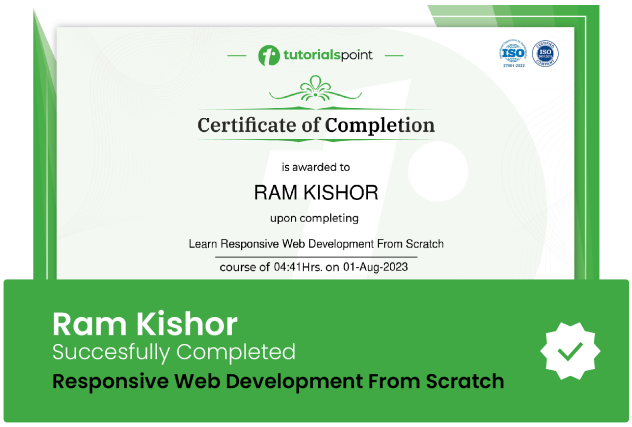NestJs Course: Modern ways to build APIs with Typescript and NestJs
Step by Step guide to build Restful and GraphQL APIs with Node.Js, Nest.Js, MongoDB, Mysql, Postgres, and Typescript etc

Lectures -42
Resources -35
Duration -7 hours

30-days Money-Back Guarantee
Get your team access to 10000+ top Tutorials Point courses anytime, anywhere.
Course Description
Nest.js is a progressive Node.js framework for building efficient, reliable and scalable server-side applications. NestJS is a server-side (backend) application framework beautifully crafted to support developers productivity and make their lives happier. Well, it's not only a framework, it's an enabler of entering the world of advanced engineering concepts such as Domain Driven Design, Event Sourcing, Microservices architecture.
I spent a good few years in my career developing large scale apps and it didn’t let me down any single time. It’s well written, having quality as an objective, modular web framework with a good documentation, delivering nice developer experience. Exactly the same way I’d describe Nest.
NestJs is built on the top of Typescript and Express.js. It also combines some elements of Object Oriented Programming and functional programming.
Here comes NestJS, a framework which is fully written in TypeScript (it supports JS too, but types are good), it’s easily testable and brings in all the necessary stuff you always think about but you don’t know what to choose.
Why NestJs?
NestJS doesn’t try to limit you to a particular way of doing things, it just provides the tooling you need. It doesn’t try to reinvent the wheel, it utilize existing tools you already know. For example, it uses express behind the scenes which makes your app compatible with the majority of express middlewares.
Here are some good reasons why NestJS shines:
Dependency Injection — NestJS provides DI straight out of the box, increasing efficiency, modularity and testability of applications.
Modularisation — NestJS provides a modular structure for organizing code within the same domain boundary into separate modules.
Flexibility — NestJS provides structure, which helps large teams build complex applications and yet comes in as lightweight as possible, so how you want to build is your choice.
Familiar APIs you already know — NestJS is heavily inspired by Angular, it is also quite similar to much established frameworks like Spring and .NET. This provides a shorter learning curve and lower entry threshold for developers.
Community — NestJS is the fastest rising framework, already with 14K stars surpassing HapiJS. Also, with NestJS leveraging on the Angular way of doing things, things can only get better for the community.
In this course, I will teach you the foundations/fundamentals of NestJs. I will teach you how to build RESTFUL APIs step by step. You will also learn how to plan, design and deploy APIs. I have also another separate section of GraphQL.
Who this course is for:
- Intermediate JavaScript developers who want to dive into back-end development
- Any developer wants to learn how to build backend server side applications with Typescript
- Developers who want to learn how build Restful apis with NestJs, MongoDB and MySQL
- Developers who want to learn how to secure your APIs using JWT
- Developers who want to learn how to deploy NestJs application
- Developers who want to learn how to GraphQL APIs with NestJs
Goals
What will you learn in this course:
- NestJs Fundamentals
- Typescript Decorators, Generics and Classes
- Build RESTFUL APIs with NestJs and MongoDB
- Build RESTFUL APIs with NestJs and MySQL
- Build RestFUL APIs with NestJs and PostgresQL
- Deploy RESTFUL APIs
- Build GraphQL APIs with NestJs
- Add Documentation for your APIS
- Authentication and Authorization using PassportJs
Prerequisites
What are the prerequisites for this course?
- Having a basic understanding of JavaScript and/or NodeJS
- Having basic knowledge of TypeScript is recommended, but not required

Curriculum
Check out the detailed breakdown of what’s inside the course
Getting started with NestJs
5 Lectures
-
Introduction to NestJs 05:59 05:59
-
Routing in NestJs 03:25 03:25
-
Access Express request Object in NestJs 04:35 04:35
-
Define Resources 03:45 03:45
-
Status Code, Redirection and Route Parameters 03:35 03:35
CRUD With NestJs
4 Lectures

Pipes and Validations
3 Lectures

Middlewares and ExceptionFilters
3 Lectures

Interceptors
2 Lectures

Connecting NestJs app with TypeORM and Mysql
3 Lectures

Relations between Entities
4 Lectures

Connected NestJs App to MongoDB using Mongoose
2 Lectures

Authentication
5 Lectures

Create Documentation for REST APIs using Swagger
2 Lectures

Deployment
1 Lectures

Connect NestJs to PostgreSQL and Sequlize
2 Lectures

Build GraphQL APIs with NestJs
3 Lectures

Serialization
1 Lectures

Task Scheduling
1 Lectures

Instructor Details

Haider Malik
eCourse Certificate
Use your certificate to make a career change or to advance in your current career.

Our students work
with the Best


































Related Video Courses
View MoreAnnual Membership
Become a valued member of Tutorials Point and enjoy unlimited access to our vast library of top-rated Video Courses
Subscribe now
Online Certifications
Master prominent technologies at full length and become a valued certified professional.
Explore Now


 Updated on Apr, 2024
Updated on Apr, 2024
 Language - English
Language - English